Small representatives of the Serranidae family are some of the most frequent coastal trophies of the fans of fishing with spinning rods in the Adriatic, and their big brothers of the same family are some of the most desired.
The Serranidae family comprises 75 genera and about 550 species of fish. Their sizes range from 10 centimeters and several dozens of grams to more than considerable dimensions. Giant grouper (Epinephelus lanceolatus), which inhabits the Indian and Pacific Oceans, can be up to 2.7 meters long and weigh about 400 kilograms, is the largest fish of the family.
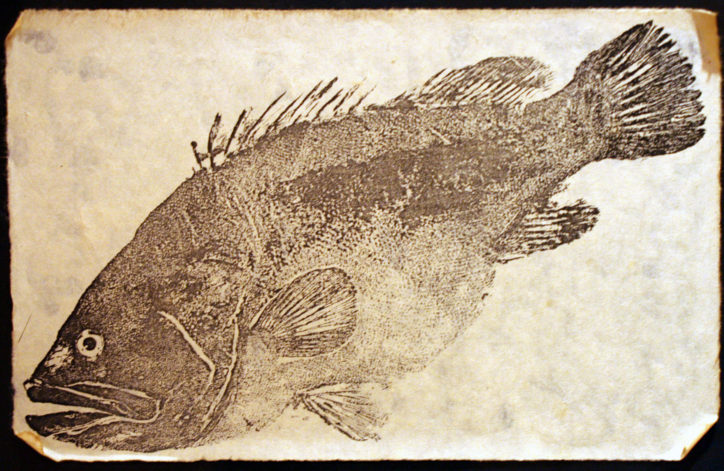
(Fish Print 魚拓(Gyotaku). Photo by J.G. Wang. flickr.com/photos/pcfannet/66213323)
However, Atlantic goliath grouper (Epinephelus itajara) is, perhaps, the most popular with fishermen. This fish has become widely known due to the large number of photos and videos shot by divers and fishermen off the coast of Florida (USA), Brazil and other countries of the Pacific coast. The fish can be up to 2.5 meters long and weigh more than 360 kilograms.
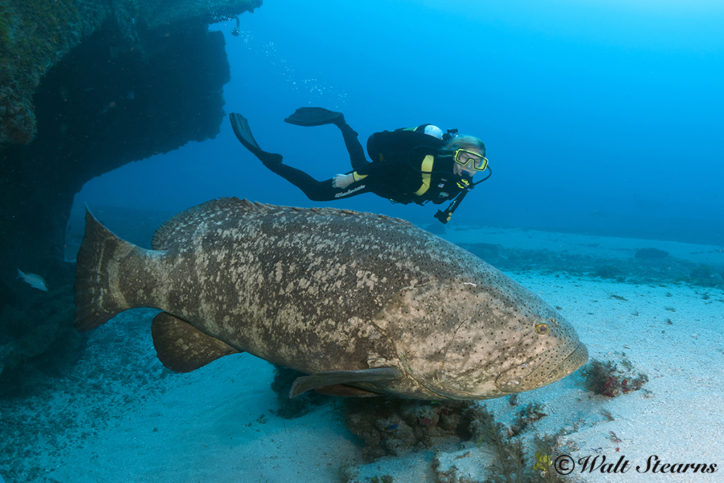
(Atlantic goliath grouper. Photo by © Walt Stearns. xray-mag.com)
Serranidae inhabit all tropical and subtropical seas of the world, they often prefer to swim above reefs or close to a rocky bottom. The vast majority of fish are ambush predators that have a strong body, large mouth with several rows of small teeth.
Most fish of the family are hermaphrodites, which are characterized by dichogamy; females eventually become males.
10 representatives of the family of 2 subfamilies and 3 genera are found in the Adriatic Sea.
The Serraninae subfamily comprises 13 genera, one of which is the Serranus genus, which includes 30 species of medium-sized fishes inhabiting the Atlantic, Pacific and Indian Oceans. Ambush predators are hermaphrodites. Three representatives of the genus inhabit the Adriatic:

(Comber. Photo by © Sacha Lobestein. enelmar.es)
It inhabits the depth of 5-500 meters, more often up to 50 meters. It prefers to swim close to a rocky, sandy and silty bottom, as well as in the thickets of Posidonia. The maximum recorded length is 40 cm, specimens up to 25 cm long are more common. The maximum weight is about 500 grams. It feeds on fish, cephalopods and crustaceans. It is a permanent inhabitant of the Adriatic Sea.
Brown comber (Serranus hepatus).
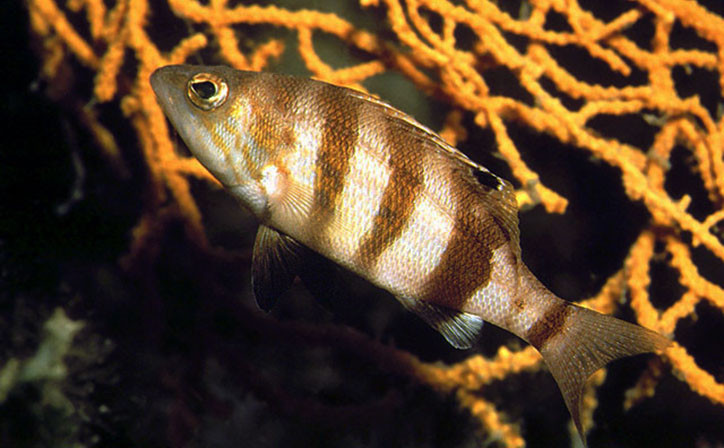
(Brown comber. Photo by © Robert A. Patzner. fishbase.org)
It inhabits the depth of 5-100 meters. It prefers to swim close to a sandy, silty bottom amidst stones and thickets of sea grass. The maximum recorded length is 25 cm, specimens up to 15 cm long are more common. It feeds on crustaceans, mollusks and small fish. It is a permanent inhabitant of the Adriatic Sea.
Painted comber (Serranus scriba).
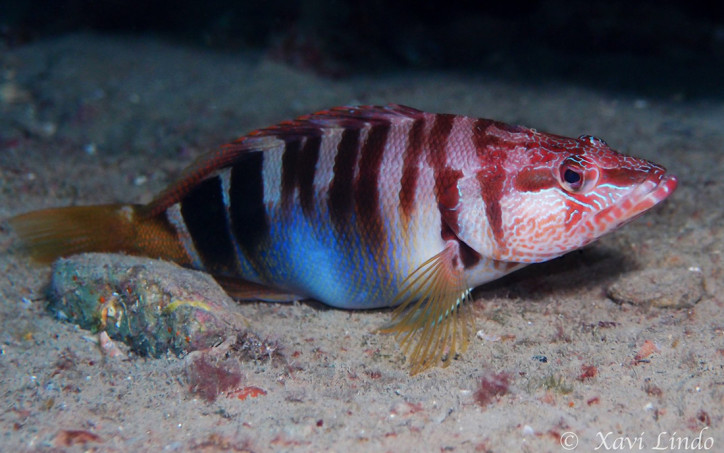
(Painted comber. Photo by © Xavi Lindo. xavilindo.cat)
It inhabits the depth of 5-150 meters, usually up to 30 meters. It prefers to swim close to a rocky bottom, often in thickets of Posidonia. The maximum recorded length is 36 cm, specimens up to 25 cm long are more common. The maximum weight is about 600 grams. It feeds on fish and crustaceans. It is a permanent inhabitant of the Adriatic Sea.
The Epinephelus genus of the Epinephelinae subfamily (including 22 genera) comprises about 90 fish species. Their sizes range from 20 centimeters to more than 2.5 meters, weight – from 100 grams to 400 kilograms. They are mostly found in the Indo-Pacific region. Epinephelus coloration is changeable and may change depending on environmental conditions. The structure of the upper jaw is a peculiar feature of the fish. The upper jaw can be advanced forward, so the mouth becomes tube-shaped, which enables the fish to suck in prey with force. 5 representatives of the genus are found in the Adriatic Sea:
White grouper (Epinephelus aeneus).

(White grouper. Photo © bastia-offshore-fishing)
It inhabits the depth of 20-200 meters. It prefers to swim close to a rocky, silty and sandy bottom. The maximum recorded length is 120 cm, specimens up to 60 cm long are more common. The maximum weight is 25 kilograms. It feeds on fish, crustaceans and cephalopods. It is a permanent rare inhabitant of the Adriatic Sea. It almost never occurs in the northern part. It is put on the IUCN Red List as a near threatened (NT) species.
Dogtooth grouper (Epinephelus caninus).
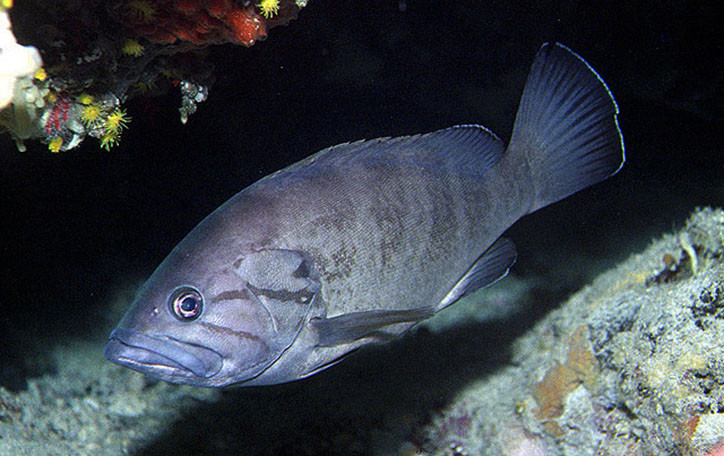
(Dogtooth grouper. Photo by © Robert A. Patzner. fishbase.org)
It inhabits the depth of 30-400 meters. It prefers to swim close to a sandy and silty bottom, not far from rocky ridges and detached boulders. The maximum recorded length is 164 cm. The maximum weight is 80 kilograms, specimens up to 35 kilograms are more common. It feeds on fish and invertebrates. It is a permanent rare inhabitant of the Adriatic Sea. It doesn’t occur in its northern part.
Orange–spotted grouper (Epinephelus coioides).
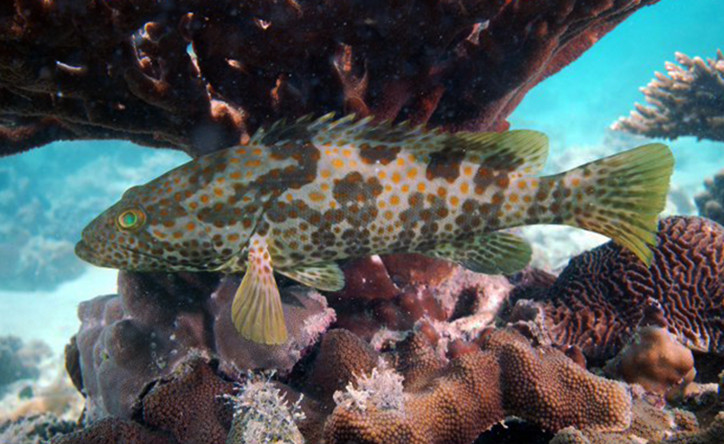
(Orange-spotted grouper. Photo by © John Burt. fishbase.org)
It inhabits the depth of 1-100 meters. It prefers to swim close to a muddy bottom near the rocks. It is a solitary predator. Juveniles enter estuaries and bays. The maximum recorded length is 120 cm. The maximum weight is 15 kilograms. It feeds on medium-sized fish, shrimps and crabs. It is a very rare inhabitant of the Adriatic. Most likely, it penetrated into the Mediterranean Sea through the Suez Canal. The fish was found in the northern part of the sea in the Trieste region, Italy, several times.
Goldblotch grouper (Epinephelus costae).
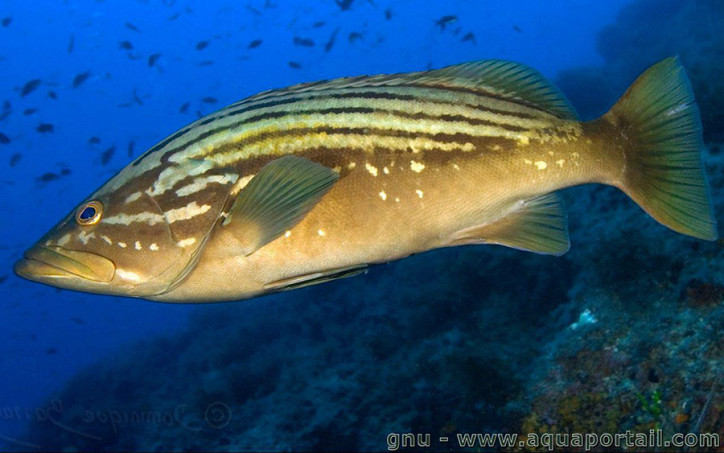
(Goldblotch grouper. Photo © www.aquaportail.com)
It inhabits the depth of 1-200 meters, usually 4-160 meters. It prefers to swim close to a rocky bottom, rocky ridges and detached boulders. Small fish arrange small schools. The maximum recorded length is 140 cm, specimens up to 40 cm are more common. The maximum weight is 15 kilograms. It feeds on crustaceans, fish and mollusks. It is a permanent inhabitant of the Adriatic Sea, which is more often found in its southern part.
Dusky grouper (Epinephelus marginatus).
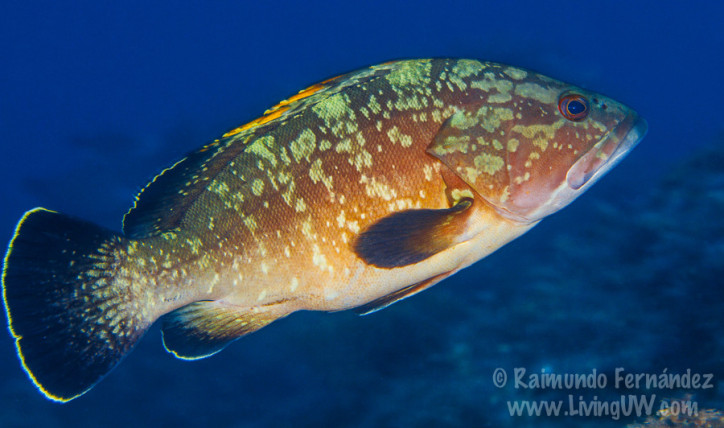
(Dusky grouper. Photo by © Raimundo Fernandez. flickr.com/photos/rferdiez)
It inhabits the depth of 8-300 meters, usually up to 50 meters. It prefers to swim close to a rocky bottom. It is a solitary species. The maximum recorded length is 150 cm. The maximum weight is over 60 kilograms. It feeds on fish, crabs and octopuses. It is a permanent inhabitant of the Adriatic Sea. It is put on the IUCN Red List as a vulnerable species (VU).
The Epinephelinae subfamily also includes the Mycteroperca genus, which comprises 15 fish species that inhabit the tropical and subtropical waters of the Atlantic and Eastern Pacific Oceans. Like fishes of the Epinephelus genus, to which Mycteroperca are very closely related in an anatomical way, they prefer to swim above coral reefs and a rocky bottom, chasing their prey from the ambush. Juveniles are often found at shallow depths close to a rocky bottom, in thickets of vegetation. They also approach river mouths. One representative of the genus inhabits the Adriatic Sea:
Mottled grouper (Mycteroperca rubra).
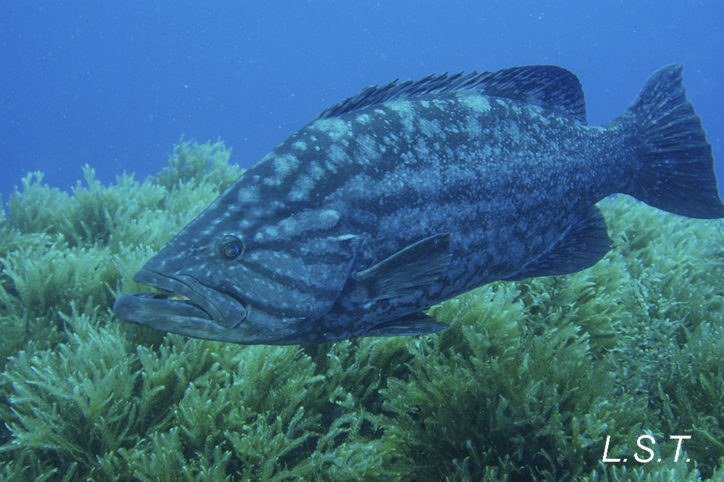
(Mottled grouper. Photo by © Luis Sánchez Tocino. litoraldegranada.ugr.es)
It inhabits the depth of 15-200 meters, usually up to 50 meters. It prefers to swim close to a rocky and sandy bottom. The maximum recorded length is 144 cm, specimens up to 80 cm long are more common. The maximum weight is about 50 kilograms. It feeds mainly on cephalopods and fish. It is a permanent rare inhabitant of the Adriatic Sea, extremely rare in its northern part.
The Anthiinae subfamily comprises about 30 genera with more than 210 fish species. They are mostly medium-sized, brightly colored fish of various colors, inhabiting areas near coral reefs and arranging huge schools. Almost all videos about the underwater world of reefs contain shots of these fishes. Due to its small size and beautiful color, fishes of the Anthiinae subfamily have become popular in aquarium husbandry as well.
The Anthias genus of the Anthiinae subfamily comprises 8 fish species. Most of them inhabit areas near deep reefs in the tropical and subtropical waters of the Atlantic Ocean, one species is found in the eastern Pacific Ocean. Only one representative of the subfamily and genus is found in the Adriatic Sea:
Swallowtail seaperch (Anthias anthias).
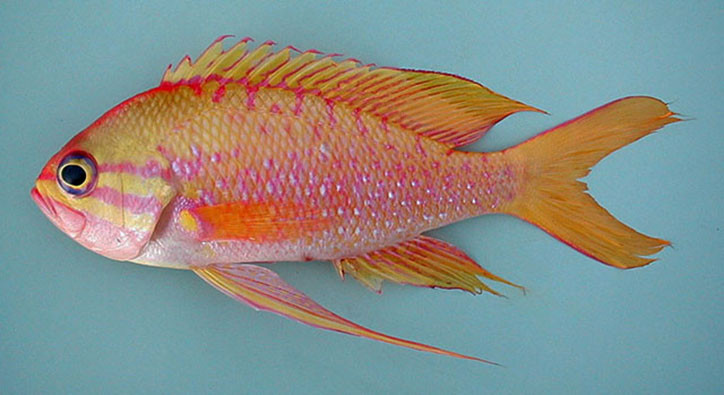
(Swallowtail seaperch. Photo by © Pedro Niny Duarte(c)ImagDOP. fishbase.org)
It inhabits the depths of up to 300 meters, usually 30-50 meters. It prefers to swim close to a rocky and gravel bottom. It inhabits caves and other shelters. It has nocturnal habits. The maximum recorded length is 27 cm; specimens up to 15 cm long are more common. It feeds on crustaceans and small fish. It is a permanent rare inhabitant of the Adriatic Sea, which is more often found in its southern part.
Fishes of the Polyprionidae family externally resemble fishes of the Epinephelinae subfamily. Nevertheless, they are even classified as a separate family. Six species of deep-sea large fish belonging to two genera are predators, which have sedentary life. Mature Polyprionidae fish can be found at great depth near the shipwrecks and caves. Thus, they got their English name – “wreckfish”. Juveniles often arrange small schools, chasing the objects floating on the surface of the sea. The largest representative of the family, giant sea bass (Stereolepis gigas), inhabiting the North Pacific, can be 2.5 meters long, the maximum recorded weight is 255 kilograms, but some evidence suggests that it can be up to 360 kilograms. One representative of the family is found in the Adriatic Sea:
Wreckfish, or Atlantic wreckfish (Polyprion americanus).
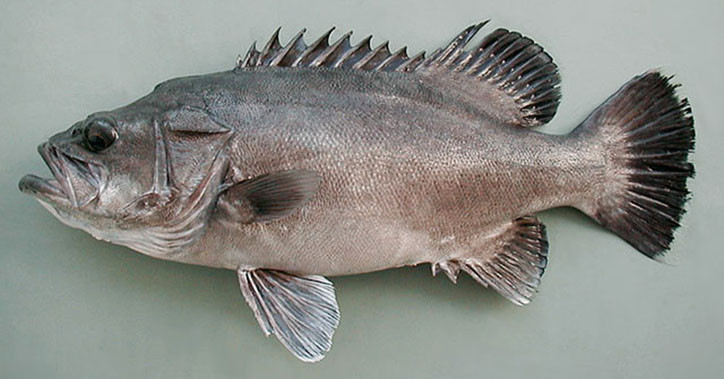
(Wreckfish. Photo by © Pedro Niny Duarte(c)ImagDOP. fishbase.org)
It inhabits the depth of 40-600 meters, usually 100-200 meters. It inhabits caves, shipwrecks and other shelters. Juveniles are found near the surface, sometimes hiding under drifting objects. Mature fish are usually solitary predators. The maximum recorded length is 210 cm, specimens up to 80 cm long are more common. The maximum weight is about 100 kilograms. It feeds on large crustaceans, cephalopods, and fish. It is a rare permanent inhabitant of the Adriatic Sea, which is more often found in its southern part.